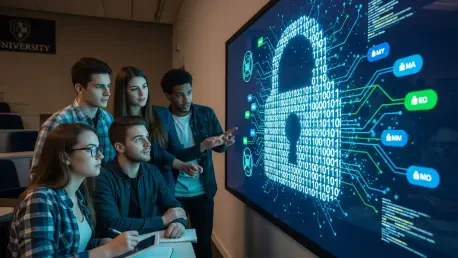In a world where cyber threats loom larger than ever, with over 700,000 cybersecurity jobs unfilled across the United States, one unexpected institution is stepping up to bridge the gap by training the next generation of cyber defenders. Nestled in the quiet town of Madison, South Dakota, Dakota State University (DSU) is emerging as a powerhouse in cybersecurity education, proving that innovation can thrive far from the tech giants of Silicon Valley or the policy corridors of Washington, D.C. What drives this small university to tackle such a massive national challenge, and how is it redefining the landscape of cybersecurity education?
The significance of DSU’s rise cannot be overstated. As cyberattacks grow in sophistication—fueled by advancements in artificial intelligence and quantum computing—the demand for skilled professionals has become a critical issue of national security. This institution’s unique approach, blending cutting-edge facilities with hands-on training, positions it as a vital player in addressing the workforce shortage. Beyond filling jobs, DSU is also working to keep talent in the Midwest, challenging the brain drain to coastal hubs and fostering a new era of regional tech growth.
A Hidden Gem in the Midwest: DSU’s Unexpected Rise
Tucked away in a town of fewer than 7,000 residents, Dakota State University might not seem like the epicenter of a technological revolution. Yet, this small campus has gained national recognition for its role in cybersecurity education. With a mission to prepare students for high-stakes digital defense, DSU has carved out a niche that rivals many larger, urban institutions, drawing attention from government agencies and private industries alike.
What sets this university apart is its ability to punch above its weight. Holding all three National Security Agency (NSA) Center of Academic Excellence designations—covering cyber defense, offense, and research—DSU stands among an elite group of only 11 universities nationwide. This rare distinction highlights a commitment to excellence that is transforming a rural corner of South Dakota into a beacon for aspiring cyber professionals.
The impact extends beyond campus borders. By focusing on real-world skills and innovative programs, the university is not just educating students but also reshaping perceptions about where tech talent can flourish. This Midwestern hub is proving that location is no barrier to making a significant mark on a field critical to the nation’s future.
The Cyber Crisis: Why Skilled Warriors Are Needed Now
The cybersecurity landscape paints a stark picture of urgency. According to industry estimates, the global shortage of qualified cyber professionals exceeds 3 million, with a significant portion of those gaps in the United States. Government agencies, corporations, and critical infrastructure sectors are all scrambling to protect against increasingly complex threats that can cripple economies or compromise national defense.
Emerging technologies are amplifying these risks. Artificial intelligence enables more sophisticated phishing attacks, while quantum computing threatens to break traditional encryption methods. These evolving dangers underscore the need for a workforce equipped not just with theoretical knowledge but with practical expertise to counter threats in real time, making educational institutions pivotal in this fight.
DSU’s role in this crisis is both timely and essential. By training students to address current and future challenges, the university directly contributes to safeguarding digital infrastructure. Its focus on accessibility—offering education in a region often overlooked by tech industries—ensures that talent development isn’t confined to traditional powerhouses, broadening the pool of defenders ready to tackle the cyber battlefield.
Cutting-Edge Tools: DSU’s Programs and Facilities
At the heart of DSU’s success lies its investment in state-of-the-art infrastructure that prepares students for the realities of cybersecurity work. The Sensitive Compartmented Information Facility (SCIF), a secure environment for classified research, allows students and faculty to engage in high-level projects typically reserved for government settings. This rare asset provides a unique training ground unlike anything found at most universities.
Adding to this impressive lineup is the Applied Research Lab, a multimillion-dollar facility opened recently with support from philanthropist Denny Sanford and state funding. Designed to rival tech clusters like Silicon Valley, this lab enhances research capabilities and positions South Dakota as a contender in the cyber innovation space. It serves as a hub for collaboration, drawing industry interest and fostering advancements in the field.
Beyond facilities, DSU emphasizes practical learning through simulation exercises, virtual computing labs for attack-and-defend scenarios, digital forensics labs aiding law enforcement, and an on-campus Security Operations Center (SOC). These resources ensure students gain operational experience, from responding to simulated breaches to monitoring real-time threats. Such hands-on training is key to producing graduates who can step directly into critical roles upon leaving campus.
Leadership and Vision: The Minds Behind DSU’s Mission
Driving DSU’s transformation is President José-Marie Griffiths, whose leadership since 2015 has elevated the university’s standing in cybersecurity education. Griffiths has articulated a clear goal: to reverse the talent migration to coastal regions by building a robust cyber research sector in South Dakota. “The Midwest has untapped potential,” she has noted, emphasizing the need to create opportunities where few existed before.
Her vision is backed by tangible achievements. Under her guidance, DSU has not only secured prestigious NSA designations but also cultivated partnerships with federal agencies and private entities. Griffiths points to student experiences in the SOC as proof of impact, where learners manage live threat data, gaining skills that make them indispensable to employers from day one.
Student perspectives add depth to this narrative. One undergraduate described a cyber incident simulation as “eye-opening,” noting how it mirrored real-world challenges faced by state governments. Such firsthand accounts reveal how DSU’s leadership translates strategic goals into meaningful outcomes, ensuring that the university’s influence resonates with those it serves.
Pathways to Success: DSU’s Blueprint for Cyber Careers
For those eyeing a career in cybersecurity, DSU offers a clear and actionable roadmap. Its curriculum spans undergraduate degrees to a PhD in Cyber Operations, blending academic rigor with applied learning. This structure ensures that graduates are not just knowledgeable but also ready to tackle professional challenges immediately after completing their studies.
The training process is meticulous and immersive. Students engage in cyber incident simulations that replicate breaches affecting businesses or local governments, sharpening their problem-solving abilities. Virtual labs provide safe spaces to practice offensive and defensive tactics, while the SOC offers real-world exposure to threat monitoring and response, creating a seamless transition from classroom to career.
This model serves as a potential template for other institutions. By prioritizing practical skills alongside theory, DSU demonstrates how to prepare a workforce capable of meeting today’s digital demands. Aspiring professionals and educators alike can look to this approach as a way to address the persistent shortage of talent, ensuring that more regions can contribute to national cybersecurity efforts.
Reflecting on a Legacy of Innovation
Looking back, Dakota State University has carved a remarkable path by transforming from a regional school into a national leader in cybersecurity education. Its dedication to hands-on training, advanced facilities, and a vision for regional growth has had a profound impact on both students and the broader field. The university’s efforts show that innovation can thrive beyond traditional tech hubs, leaving a lasting mark on how talent is developed.
The journey highlights a critical lesson: addressing the cyber workforce shortage requires bold, localized solutions. DSU’s success in retaining talent in the Midwest and producing job-ready graduates offers a blueprint for others to follow. As cyber threats continue to evolve, the groundwork laid by this institution remains a cornerstone of resilience.
Moving forward, the focus shifts to scaling such models across other regions. Stakeholders, from policymakers to educators, should consider investing in similar programs that prioritize practical skills and accessibility. By doing so, the nation can build a more robust and diverse cyber workforce, ensuring that the legacy of innovation sparked in South Dakota continues to inspire and protect for years to come.









